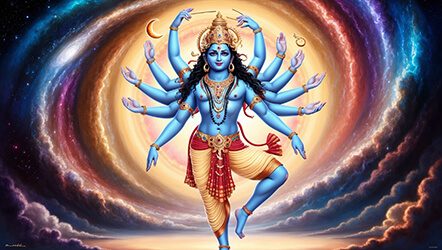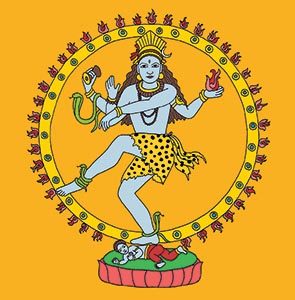
Nataraja Symbolism: Cosmic Dancer
Nataraja is a form of Shiva, the third god in the Hindu trinity of deities This trinity also includes Brahma the creator and Vishnu the preserver. As Nataraja, Shiva embodies the cosmic cycles of creation and destruction, the balance of dynamic energy and stillness, and the unity of all opposites.
Nataraja and the Crown Chakra
In addition, Nataraja (sometimes called Nataraj) is one of the presiding deities for the crown chakra. The crown chakra is the seventh chakra, the seat of enlightenment, known in Sanskrit as the Sahasrara chakra. Sahasrara means “thousand-petaled.” According to Eastern traditions, the crown chakra is related to god-consciousness (samadhi). Learn more in our article on the Crown Chakra.
Share this page with a friend!
Watch nearly 400 videos on the Vocal Medicine Channel!
Nataraja Mantra Meaning
This video features a traditional mantra associated with Nataraja. The meaning of this chant is “Salutations to the beautiful dancing Nataraja, the Lord Shiva, whose consort is Shivakami. Honor to Shiva who is the master of the sky of consciousness. Nataraja is the lord of the city of Parthi.”
Nataraja, Nataraja, Nartana Sundara Nataraja (2x)
Shivaraja, Shivaraja, Shivakami Preya Shivaraja (2x)
Chidambaresa Nataraja, Parthi Puresa Shivaraja
The Dance of Nataraja
The dance of Nataraja is called Tandava. The dance is the source of all movement within the universe. The gestures of the Tandava indicate five activities of Shiva. They are creation (symbolized by the drum), protection (the upraised hand), grounding and claiming the earth (the foot on the ground), destruction (the hand holding fire), and release (the upraised foot).
Nataraja: king of dancing
Sundara: beautiful or handsome
Shivaraja: variation on the name of Lord Shiva, the royal Shiva
Shivakami: the beloved (wife) of Lord Shiva
Preya or priya: dear
Chidambaresa: the sky of consciousness
Parthi: city of Parthi
Puresa: lord of a place or city
Modern Nataraja Symbolism
In the vast pantheon of Hindu deities, Nataraja, also known as the Lord of the Dance, stands as one of the most iconic and deeply symbolic representations of divinity. This dancing form of Shiva is a joyful being spinning throughout creation. In this way, Nataraja represents the ecstatic state of ultimate enlightenment.
Nataraja Symbolism and Science
Nataraja symbolism has transcended religious and cultural boundaries. It has become a symbol of Indian artistic achievement as well as scientific insight. Notably, a statue of Nataraja stands at the CERN laboratory in Geneva, Switzerland. In this context, Natraja symbolizes the connection between ancient cosmological thought and modern particle physics.
Nataraja and The Tao of Physics
Physicist Fritjof Capra, in his book The Tao of Physics, noted that the dance of Nataraja resembles the dynamic patterns observed in quantum physics—matter in motion, energy in flux, and the continual transformation of the cosmos.
Nataraja as a Dynamic Principle
Nataraja is far more than a mythological figure; he is a symbol of a dynamic cosmic principle and the path to inner awakening. With roots in the Vedas and deep elaboration in Puranic and Tantric texts, his image synthesizes art, science, and spirituality.
Significance of Nataraja’s Dance
As the Chidambaram Mahatmyam states: “He who understands the dance of Nataraja understands the mystery of the cosmos.” Thus, the dance of Shiva is not merely a spectacle—it is an invitation to transcend ignorance, merge with the divine, and participate in the great cosmic rhythm of life.

Specific Symbols of Nataraja
Nataraja has multiple arms (usually four), each holding symbolic objects. In this form, Shiva represents all three states of life: creation, preservation and destruction. In other forms, Shiva may depict only his primary role, which is destruction. As Nataraja, he symbolizes the constant motion or dance of life all the way down to subatomic particles.
Ring of Fire: Nataraja dances within a ring of fire, symbolizing the circular nature of time. The ring of fire is called the prahbha mandala.
Drum (Upper Right Hand): His upper right hand holds a drum (damaru) that makes the fundamental sound of creation. The drum has an hourglass shape. The sounds that are created are called Shrishti (creation, evolution). As stated in the Shiva Purana, “From the damaru emerged the primal sound Om, which gave rise to the Vedas and the world itself” (Shiva Purana, Rudra Samhita, Chapter 2).
Fearlessness Mudra (Lower Right Hand): Nataraja’s lower right hand is in the fearlessness mudra or gesture (abhaya mudra). This is the energy of Sthiti (support, preservation). The gesture also represents protection.
Demon Under Right Foot: Nataraja’s right foot stands on a smaller being representing the human ego and ignorance. This is the energy of Tirobhava (illusion, veiling). Nataraja’s stance indicates that he is the master of understanding and has put down all forms of illusion. The suppression of the demon under Nataraja’s foot reflects the need to overcome ignorance (avidya) to achieve self-realization (atma-jnana). As the Tirumantiram scripture, declares: “His foot, the refuge of the pure-hearted, crushes ignorance with every beat.” (Verse 2750)
Uplifted Left Foot: Nataraja’s uplifted left leg symbolizes grace and liberation. His upper left hand holds a blazing flame.
Agni or Fire (Upper Left Hand): In his upper left hand, Nataraja holds agni (fire), which signifies destruction. This is not annihilation but transformative destruction, as emphasized in the Linga Purana: “Fire purifies all that it consumes, and through destruction, new birth becomes possible” (Linga Purana, Chapter 49).
Pointing Finger (Lower Left Hand): His lower left hand points to the upraised left foot, indicating the path of freedom. This is the energy of Anugraha (grace, emancipation). Nataraja gestures across his body toward his raised foot, guiding devotees to refuge and spiritual upliftment.
Serpent Around His Neck: The serpent often shown around Nataraja’s neck (and in most depictions of Shiva’s other various forms) symbolizes the kundalini or shakti energy. This is the energy at the base of the spine that rises to crown when enlightenment is reached.
Nataraja’s Earrings: Nataraja’s earrings indicate that the Divine can be expressed as feminine, masculine, a combination of both or neither. In some depictions, he wears two different earrings. On the right side, he may wear a crocodile earring, tradition for men. On the other side, Shiva may wear a circular earring typical of women.
Hair and Ganga River: Shiva’s hair spreads outward, suggesting his dynamic energy. The Ganga River, descending from the heavens, is nestled in his locks, based on the story from the Skanda Purana (Kedara Khanda) where Shiva absorbs the river’s force to save the earth.
Author Kathleen Karlsen
Kathleen Karlsen is a musician, artist, writer and speaker. She is the author of two books (Flower Symbols and Vocal Medicine) and over 200 articles. Kathleen, her husband Andrew, and their five children live in Bozeman, Montana. More about Kathleen Karlsen.
Nataraja Symbolism Article Summary
Nataraja symbolism has transcended religious and cultural boundaries. It has become a symbol of Indian artistic achievement as well as scientific insight. The specific symbols of Nataraja outline the path of spiritual awakening. Explore the meaning of the Tandava dance and Nataraja’s symbolic objects!
Click for all content on our Site Map
Listen on Spotify!
Click to hear
108x Around the Heart
Click to hear
Vocal Medicine Kirtan






